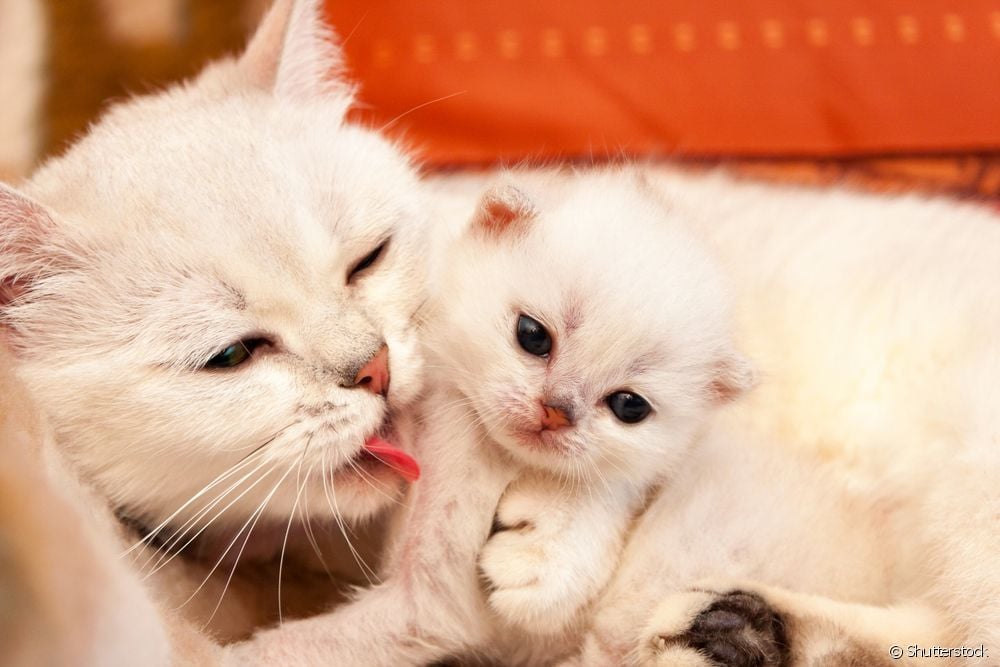Pregnant cat: 10 questions and answers about cat childbirth

Table of contents
Your cat is pregnant, congratulations! Soon the new members of the family will arrive bringing all the euphoria and excitement that only a kitten can provide. So, it's good to prepare for the cat birth. How to help in this very special moment? Despite being an independent animal, you must be present to take it to the vet, assist when necessary and ensure the most comfortable environment for your cat.That's why we've put together 10 essential questions and answers that every guardian waiting for their new pet to arrive should know.
See_also: Do cats have AIDS? See myths and truths of feline FIV1) What are the symptoms of cat pregnancy?
In general, the pregnant cat shows the first signs after the first 15 days of pregnancy. A needy cat, increased appetite, larger and reddish nipples and a growing belly are the most common signs. It is worth remembering that they can vary for each pet, so the ideal is to go to the vet. Only there will you be sure and start performing prenatal care.
2) How long does a cat stay pregnant?
Cat gestation ranges from 63 to 67 days, considered a short gestation.
3) What care should the pregnant cat receive?
Above all, avoid stress. She needs tranquility at this time, so dispense with loud noises, don't pick her up too much, make her environment clean with a comfortable bed and feed her a quality food. Also, have a veterinary follow-up. Cats can be quite free, but it doesn't mean they don't need professional care and help.
4) How many kittens are usually born in one pregnancy?
The average pregnant cat has 4 to 6 kittens, but this number varies depending on the species and can be more or less.
5) Where is the best place for cat birth?
That's up to the mom! The pregnant cat wants to be alone with her kittens at the time of birth, so don't stand too close. She'll look for a place herself, but you can prepare a comfortable environment. Put the litter tray, food bowl and water bowl there and remember it needs to be a quiet, unstirred environment. Always watch from a distance to make sure everything is OK, it's good to remember:if the cat has chosen a place that is not the one you have prepared, do not insist and let her stay where she has chosen.

6) What are the signs that it is time?
The cat begins to look for a quiet place and becomes restless. She also has a lack of appetite and her body temperature drops. When she is very close, she may start meowing intensely. When contractions begin, she releases a white vaginal fluid. Keep an eye on the color: if it is brownish, dark, or looks like blood, take her to the vet immediately.
7) How to deliver a cat?
Leave it with the cat and she will do it herself. It usually lasts from 5 to 12 hours, with an interval of 30 minutes to an hour between the birth of each kitten. If there are many, it can take up to 24 hours. But be aware that excessive delay may have other causes.
If the kitten is in the correct position, the head should come out first. It is born wrapped in a membrane that the mother herself tears. Then the cat licks the kitten to stimulate blood circulation and breathing. That is, you do not have to help with the birth itself, but keep an eye out for possible complications.
8) What complications can arise when giving birth to a cat?
Cat birth complications are called dystocias. In cat birth they are less common as the kittens are small, but they can happen, so look out for any unusual signs. The most common complications are:
- More than 2 hours since the start of labor and no puppy comes out - One of the most frequent causes is the pet being in the wrong position.
- Placental remains in the uterus - Note if the cat is slow to recover, has a fever and weakness. There may be pieces of placenta inside her uterus that need to be removed.
- Loss of uterine strength - The female may weaken in very long births and have difficulty expelling.
- Dead puppy in the womb - She also shows symptoms of weakness and the dead kitten needs to be removed from her uterus.
It is important to have your vet's contact close by to ask for help with any signs that indicate these problems. Only your vet can help in the most appropriate way.
9) What is the postpartum period like for the cat and kittens?
For the first few days, you may feel like picking up the kittens, but the best thing to do is to let the mother cat enjoy her kittens alone. Give her space and avoid holding her too much, as at this point the cat is more concerned with keeping her kittens safe and may see you as a threat.
Puppies feed on their mother's milk for approximately four weeks, so if you are going to separate them, wait until after this time to avoid nutritional deficiencies.
10) How do I know if there is still a puppy to be born?
With prenatal care, you already know how many are going to be born and then just count. In case you don't know, cat birth ends when the mother starts licking her kittens and feeding them. She also gets up and goes to drink water, trying to recover her energy.

